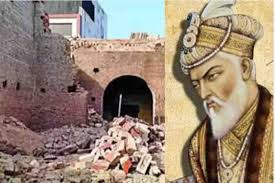Historian William Dalrymple slams demolition of Aurangzeb Haveli in Agra

New Delhi: The demolition of the iconic Mubarak Manzil, popularly known as Aurangzeb’s ‘haveli’ in Uttar Pradesh’s historic city of Agra has sparked outrage amongst many, including famed India-based Scottish historian William Dalrymple.
According to Kashmir Media Service, historian William Dalrymple wrote, “Neglect your main heritage centres, allow developers to raze all its heritage properties, and then be surprised when this great country has fewer tourists than Dubai or Singapore.”
The demolition of the 17th-century Mughal heritage site has spurred allegations of collusion between a builder and officials.
It’s almost as if India is going out of its way to destroy its appeal as a tourist destination. Neglect your main heritage centres, allow developers to raze all its heritage properties, and then be surprised when this great country has less tourists than Dubai or Singapore…
The demolition occurred just three months after the state archaeological department listed the site for protection, with over 100 tractors of debris removed from the site.
Mubarak Manzil held significant historical value serving as a residence for prominent Mughal figures, including Shah Jahan, Shuja, and Aurangzeb. The structure underwent modifications during British rule, transforming into a customs house, salt office, and eventually, Tara Niwas by 1902.
The haveli has been a subject of cultural importance, documented in historical records such as Archibald Campbell Carlyle’s 1871 report. The structure, originally built with red sandstone and featuring arched lower floors and minarets, stood as a testament to the Mughal dynasty’s grandeur.
Residents and local activists have raised serious concerns about the demolition, saying that it was carried out with the involvement of a builder, and that there was a tacit collusion between police and administrative officials. Locals reported that several complaints regarding the demolition were ignored, and no action was taken to halt the destruction of the mansion.
“It is clear that the demolition was carried out with the consent of officials, despite the site being in a sensitive location,” said one resident, who wished to remain anonymous. “The building had immense historical value, and now it’s gone.”
The demolition has sparked significant public outcry, with heritage conservationists expressing their disappointment at the loss of yet another piece of India’s Mughal history. Many are concerned that this could set a dangerous precedent for the treatment of historical sites in the region.
The demolition of Mubarak Manzil has not only erased a significant piece of Mughal history but also raised serious questions about the role of local authorities and the protection of heritage sites in India. As the investigation unfolds, the community and heritage groups will be watching closely to ensure that justice is served and that such destructive actions are prevented in the future.








